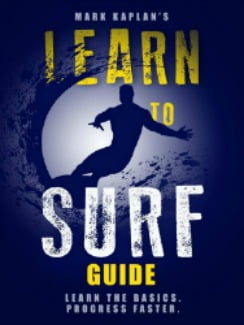Progress to Short Board Surfing
Progress to short board surfing by first mastering the techniques on soft top boards and foam waves. Many new surfers are motivated by the surfers they see in movies riding short boards. They don’t realize this talent takes years of development.
Three or four things beginners surfers don’t have to enable them to ride short boards are the techniques, the ability to judge waves, the strength nor the stamina and the courage.
Learning the Necessary Surfing Techniques
The beginner surfer starts with a high volume foam board so that they can easily catch waves, easily paddle, and easily ride. This doesn’t mean it is easy. No. Learning the techniques is difficult but new students want to minimize the difficulty by using the easiest board and riding the easiest waves.
The surf student first learns how to roll over on the soft top and time incoming foam waves. They paddle to get moving before the wave arrives and paddle hard when the foam wave is close to the board. This technique is mimicked on real waves. The surfer lets the wave roll under him and arc before paddling hard down the face.
The new surf student masters the pop up so he lands on the board in the correct posture. He wants his feet shoulder width apart with the front foot at a 45 degree facing forward more than halfway to the nose.
Most important is he wants his hips and shoulders square to the front. Many beginners do a pop up where their butt is over one rail in what I call snowboarding because one should and hand trail. The shoulders and hips should be square to the front.
After mastering the pop up, the surfer learns to paddle out through waves and turn around to catch bigger foam waves and start catching real waves. This progresses on a foam board before the student starts thinking of a hard board or shorter board.
The Move to Short Boards
The move to hard boards and shorter boards should progress slowly. No one wants to take the fun out of surfing. Shorter boards are harder to paddle. Surfers should move down in length six inches at a time and maintain the width and thickness of a high volume board. A 7′ 6″ fun board that is 21+” wide and 2 3/4 ” thick is a great start.
The start on real waves can begin with catching two or three foot waves and catching the corners where the waves are not steep but you can still get into the pockets. As expertise increases, the surfer can start riding down bigger faces.
The surfer learns carving techniques like bottom turns and cut backs. The surfer learns to accelerate the board by pushing the nose of the board up and down the pocket with the front foot.
The adventure takes time and requires regular practice and patience. Moving too fast to shorter boards or too big of waves can steal the fun.
Learn More
For Oceanside Surf Lessons, see the Home Page
See the Post Surf Lessons Begin with Foam Waves
See the Post What You Learn in a 2 Hour Lesson
See the Post How to Progress in Surfing
See My Dry Land and In Water Demo video
See How to Catch a Green/Real Wave video
i have lowered my book and course prices for the lock down.
My New Surfing Course in an E-Book plus Demo Video
Get the 18 Chapter, 7,500 word Course that can prepare you for a lesson or give you the fundamentals if you are going to try it on your own. 10 years of teaching 350 students a year has given me the insights on the most precise measures you must follow for success. This course is what I teach on the dry land and in water instruction. The Course includes a 15 minute video on my dry land and in water demonstration. Only $4.95
Buy the E-book for $2.99. Learn to Surf (Different cover but same book)
Buy the Paperback on Amazon $6.95
Get Learn to Surf Course in 29 minute audio. Great prep for a lesson, reviewing after a lesson, learning on your own, refreshing after not having surfed for a while. See Table of Contents. Only $7.95

80 page Learn to Surf Book
![Surf Instructions Beginner to Advanced: Learn to Ride Waves by [Kaplan, Mark]](https://images-na.ssl-images-amazon.com/images/I/51HswFtoBQL.jpg)
Buy my E-book on Amazon Kindle for $2.99. 80 pages of beginner to advanced instructions to help you before the first lesson to learning expert techniques and tricks.
I also have books on Creating Your Own Happiness on a site called Happiness and Work Life Balance